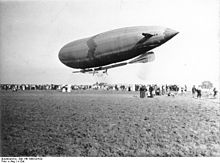Groß-Basenach
Wholesale Basenach is the name of a airship type which after the two designers Major Hans Gross , the commander of the Royal Prussian Airship Battalion in Berlin , and engineer Nikolaus Basenach (1875-1951), previously at the Stettin Vulcan shipyard was busy , was named.
A test airship and four so-called "Military-Groß-Basenach" types were manufactured in Tegel and rebuilt several times. They followed the construction principle of the semi-rigid airship , which was initially favored by the German military because of the easier transport of collapsible airships over the rigid construction of the Zeppelin type . They set some records for travel time and speed, but overall they weren't as successful as hoped. The war and the immensely increased demands on the technical possibilities of the airships initially let this system fall into oblivion. Even his competitors Parseval and Schütte-Lanz would fare no differently at the end of the First World War , albeit for different reasons. Today's airships, on the other hand, are again impact airships or of the semi-rigid type.
Airships
Experimental airship
The test airship had a volume of 1,800 cubic meters and has a keel directly under the balloon envelope. Most of it was built by Siemens-Schuckert Werke GmbH .
The first trip took place on May 7, 1907. The drive consisted of a 24 HP Gaggenau automobile engine and enabled a top speed of 29 km / h. On October 28, 1907, Captain Richard von Kehler set an endurance world record of 8 hours and 10 minutes with the airship.
The ship was later rebuilt. Among other things, tail fins were retrofitted.
MI
- 5,000 m³ volume
- Length of the gas envelope 65.5 m, diameter 11.1 m
- built by the airship battalion in Tegel
- first trip: June 30, 1908
- Drive: two Körting engines with 75 hp each
On September 21, 1908, a record continuous drive of over 13 hours was carried out. During a planned 24-hour journey, the airship stranded on November 12, 1908 after 21 hours in thick fog in the Stettiner Haff off the coast of Wollin and was damaged. On April 22, 1910, MI took part in an "airship parade" in front of Kaiser Wilhelm II in Bad Homburg, together with the Parseval airship PL 3 and the Zeppelin Z II (originally built as LZ 5 ) . In 1913 the shell was lengthened to 71.8 m. In this configuration the ship sailed for the first time on March 26, 1913. The keel was changed three times, the volume increased to 5600 m³. The top speed remained at 47 km / h despite the modifications.
M II
M II was built in 1909 and enlarged again in 1911.
- Volume: 5,200 m³
- Length: 74 m
- Diameter: 12 m
- Drive: two Körting engines with 75 hp each
- Elevation: about 1500 m
On August 4th and 5th, 1909, the airship made a sixteen-hour journey over 460 km from Tegel via Halle , Weißenfels and Apolda back to Tegel.
M III
M III was built in 1909 and made its first voyage on December 31st.
- Volume: 7,800 m³
- Length: 81.5 m
- enlarged in 1912 to a volume of 9,000 m³ a length of 83.3 m
- Drive: two Körting engines with 75 hp each
M III was the fastest airship of its time with a top speed of 59 km / h (68 km / h after conversion). It burned on October 10, 1911 in the airship hangar in Tegel.
M IV
M IV was built in 1911 and enlarged in 1913 and 1914.
- Volume: 19,000 m³
- Length: 120.7 m
- Diameter: 16.1 m
- Drive: three Maybach engines with a total of 480 hp
M IV reached a speed of 82 km / h in 1913. From December 28, 1914 to November 3, 1915, it undertook a total of 24 reconnaissance trips over the Baltic Sea . On September 10, 1915, it attacked a submarine with 100 kg bombs .
See also
literature
- G. Schmitt, W. Schwipps: Pioneers of early aviation . Gondrom Verlag, Bindlach 1995, ISBN 3-8112-1189-7 .
- N. Basenach: The three systems. In: Bröckelmann (Ed.): Wir Luftschiffer. Ullstein, Berlin / Vienna 1909, pp. 240–268.
- P. Neumann: The international airships and kites. Their design and properties as of April 1912 . Oldenburg 1912.
Web links
- Semi-rigid airships of the Groß Basenach type with pilot and airship
Individual evidence
- ^ H. Hoernes: Report on my aeronautical study trip to Germany, October 1906. Self-published, Salzburg 1906, p. 9ff.
- ↑ Continuous driving of steering balloons. Zeppelin's record beaten. Over 8 hours in the air. In: Wiener Luftschiffer-Zeitung. Volume 6, Issue 12, 1907, pp. 261-262.
- ^ Alfred Hildebrandt: The stranding of the German military airship. In: Wiener Luftschiffer-Zeitung. Volume 7, Issue 12, 1908, pp. 307-309.


